On View
Italy’s Artsiest Mayor, Massimo Mallegni, Directs Helidon Xhixha to Sculpt With Italian Marble
An Italian mayor looks to contemporary art to keep the work of traditional craftsmen relevant.
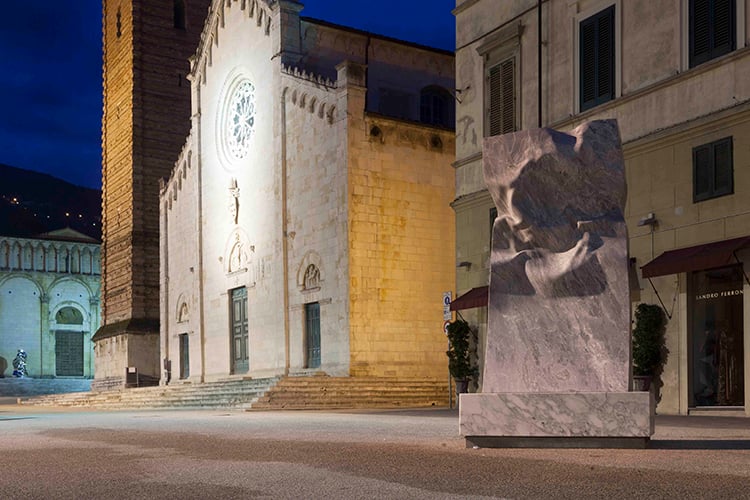
An Italian mayor looks to contemporary art to keep the work of traditional craftsmen relevant.

Dr. Diego Giolitti

It isn’t often that a mayor gets directly involved in bringing art to his or her city, but that’s exactly what happened in Pietrasanta, Italy, where it was mayor Massimo Mallegni who invited Helidon Xhixha to bring his metallic sculpture to Tuscany.
The resulting show, “Shining Rock,” expanded the artist’s practice, with Mallegni encouraging Xhixha, who is represented by Contini Art UK, to work with local artisans to translate his work from steel into bronze and marble.
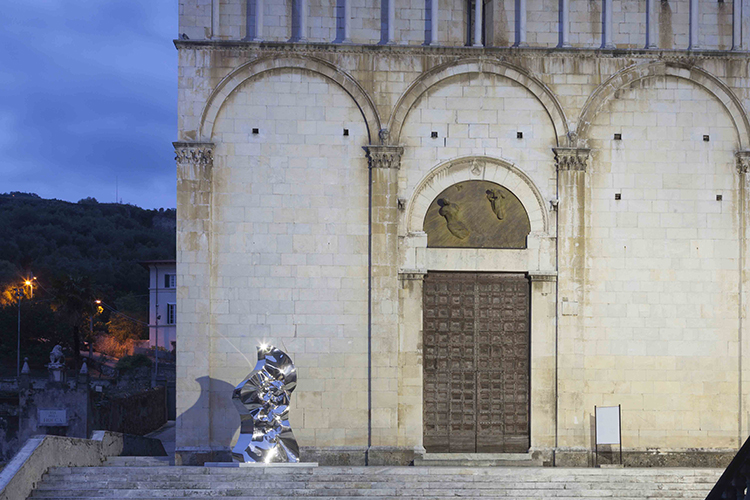
Helidon Xhixha, “Shining Rock” in Pietrasanta. Courtesy of Contini Art UK.
“Pietrasanta has a staggering history and, as we all know, is famed for some of the best quality marble in the world,” said Xhixha in a statement. “I want to show my respect for the town by referencing their significant past while at the same time displaying a transition in my own practice.”
On the occasion of the exhibition in the town piazza, which was recently extended through the end of October, Diego Giolitti, Contini Art UK’s sales director, spoke on behalf of artnet News with Mallegni. Their conversation explored the mayor’s views on art, as well as his thoughts about the past, present and future of Pietrasanta, which he proudly describes as “the leading city in Italy.”
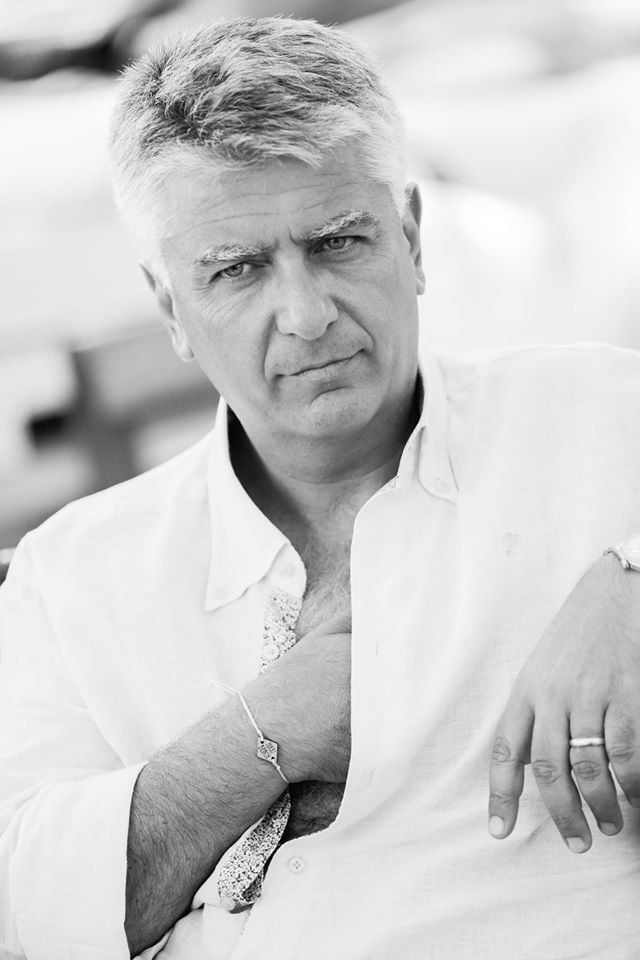
Massimo Mallegni. Courtesy of Massimo Mallegni.
Massimo, What adjectives would you use to describe your characteristics as a mayor, those which make you different from other mayors?
Narcissistic, proud, arrogant, efficient, immediate, fast, effective.
Great! I guess you said “narcissistic” because you love beauty, which means you are the right guy for Pietrasanta. Am I correct?
Yes. Of course, “narcissistic” implies being a narcissist and focusing on one’s self, but in my case that’s an exaggeration. I used the term in relation to Pietrasanta, in the sense that I want my city to be more beautiful than other cities; I believe it is the most beautiful, charming, striking and important of all cities.
I said “proud” because the Piazza del Duomo is a proud square. Its special charm is due to the fact that Pietrasanta was historically a Captaincy in Versilia, so that’s where the land reclamation process started in 1255. This territory has all the reason to feel proud of everything it has accomplished.

Helidon Xhixha, “Shining Rock” in Pietrasanta. Courtesy of Contini Art UK.
And that’s why you’re “arrogant”?
“Arrogant” because when you represent the territory it’s only fair to slam a fist on the table once in a while and declare, “Whatever we do, we must respect this land and everything it has stood for for so many centuries.”
We can’t forget that Michelangelo was the first to come here in the piazza and decide that art, sculpture, and craftsmanship were to be a leitmotif for Pietrasanta. For all these years, they have been the driving force behind the city’s existence and development. So we can say—with pride but also with objectivity… with pride but without triumphalism… with some arrogance, but without exaggeration—that Pietrasanta is the leading city in Italy.
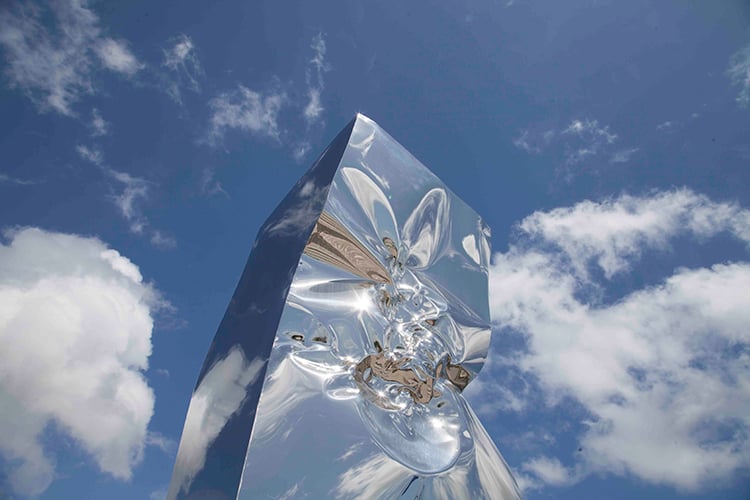
Helidon Xhixha, “Shining Rock” in Pietrasanta. Courtesy of Contini Art UK.
Let’s focus on this last point for a moment. You’re the mayor of this gem of a city, and I would like to know more about your relationship with art. How important is art for this city?
The territory of course has a long tradition of artistic workmanship and, in particular, craftsmanship. I realized that for the artisan masters of Pietrasanta (who had been completely ignored for years) to get the recognition they deserved, and to have an impact on the international market, we needed to get the most important artists in the world to work with them.
I’ve used art and craftsmanship—in particular the great artistic skills of our bronze founders, marble, and mosaic craftsmen—as a means to attract the greatest artists. There are also hundreds of artists currently living and working in Pietrasanta who are lesser known, but who provide work to our artisans and sell their pieces all over the world.
Another part of my strategy has been to place works of art out in the open, to show what people create here and seize the opportunity to decorate the major squares of the city with important works of art.
When I arrived in Pietrasanta, the only works on display were Fernando Botero’s Warrior, Igor Mitoraj’s Centaur and Francesco Messina’s The Boxer. Now there are 36 works of art across the city, including Kan Yasuda’s large-scale work The Dream in the station square, as well as many other important works by Italian and foreign artists that make Pietrasanta a real open-air museum.
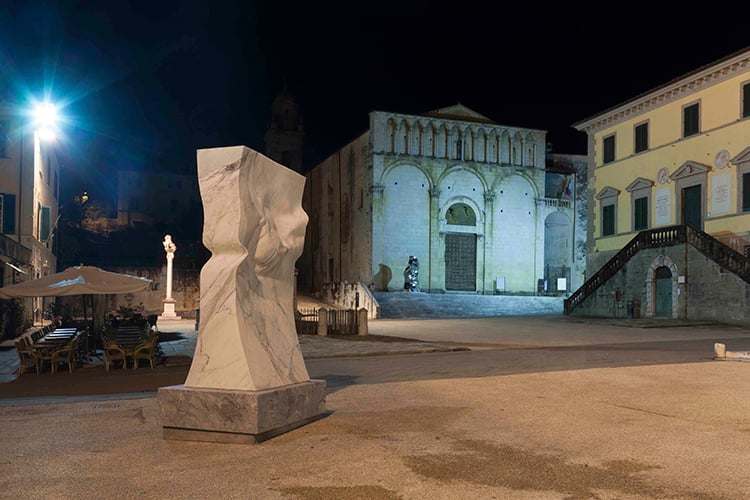
Helidon Xhixha, “Shining Rock” in Pietrasanta. Courtesy of Contini Art UK.
I’d also like to talk the on-going Helidon Xhixha exhibition. By introducing him to the craftsmen of Pietrasanta, you gave him the opportunity to learn about and experiment with marble, as well as to use steel, his favorite material. In this way, you’ve joined two sculpture traditions. It seems to me that the past, present and future are coming together here. In your opinion, how is this exhibition different from previous ones held in Pietrasanta?
When I first spoke to Helidon Xhixha three years ago, I said to him, “I’d like to organize an exhibition in Pietrasanta, but there’s one problem with you: You only work with steel. I must promote local artisans, which means I have to do that by focusing on marble and bronze working. If you feel up to trying something new and starting to work with bronze and marble, and if I become mayor,”—I was not in office three years ago—“I will make the necessary arrangements to organize a Helidon Xhixha exhibition in Pietrasanta.”
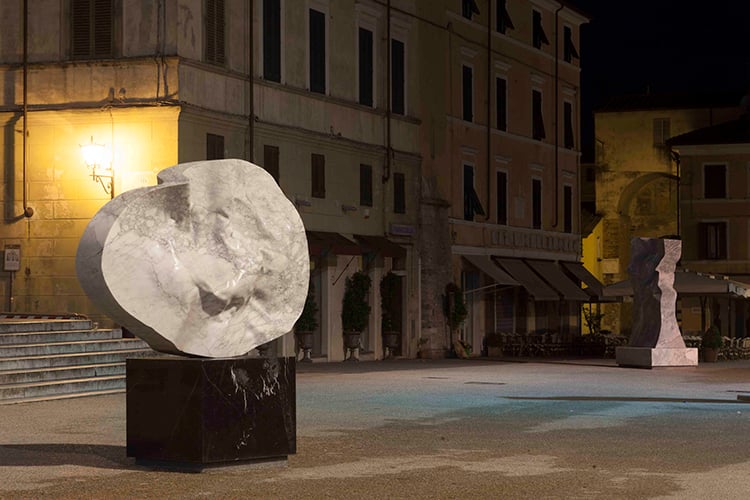
Helidon Xhixha, “Shining Rock” in Pietrasanta. Courtesy of Contini Art UK.
What was Helidon’s reaction when you encouraged him to work with a material he was completely unfamiliar with?
When I told him about the exhibition he accepted immediately, without even considering what he was getting into—now you just see the monumental sculptures on display in the piazza, but it’s been a demanding process in every aspect—financially, as well as with regard to the transportation, insurance, creation and physical arrangement of the works of art. These sculptures are heavy, from every point of view, so he’s done a really good job.
Helidon showed that he has the true artist’s genius, because he immediately put his energies into making bronze and marble, and marble and steel, meet. He had the courage not only to do that, but also to let everyone know about that experience, and, based on the exhibition, I think I can say that it’s been a very positive experience.
During this term as mayor I have tried, and will try, to promote three major exhibitions per year. One of a great up-and-coming artist during the summer, followed by one more of an established artist, and finally one featuring an artist at very start of their career.
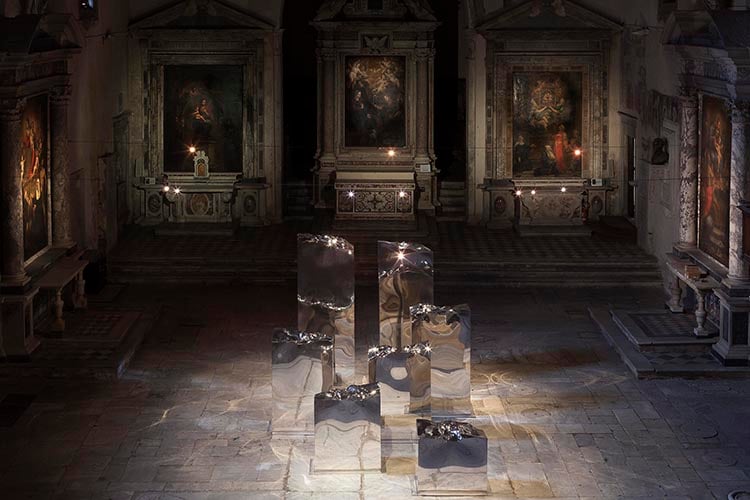
Helidon Xhixha, “Shining Rock” in Pietrasanta. Courtesy of Contini Art UK.
This is the first time that I’ve seen the mayor of a city, or in any case a political representative, getting personally involved in a project. I know that you even assisted with facilitating the transportation of the works, and that you also helped to establish a relationship and a dialogue with local companies, such as the Henraux marble quarry. This exhibition is truly a pleasant surprise; how did you managed to put all these pieces together successfully?
That’s the way I do things, I go all out in everything I do. It’s one of my personality traits. You asked me about my qualities before, and I didn’t mention my flaws when I answered your question. They include my wanting to take care of things from the birth of an idea in someone’s head to its final implementation.
This applies not only to exhibitions, but also public works, speeches, promotional activities, and my professional activities. My approach is always the same. And I believe that this is the only way of doing things.
It’s exactly like an artist who gives an artisan a sketch or a maquette of his work, rather than just telling him his idea, to make sure that what he wants is absolutely clear. He then returns to the work of art several times to shape it over and over again. That’s what the most important artists do.
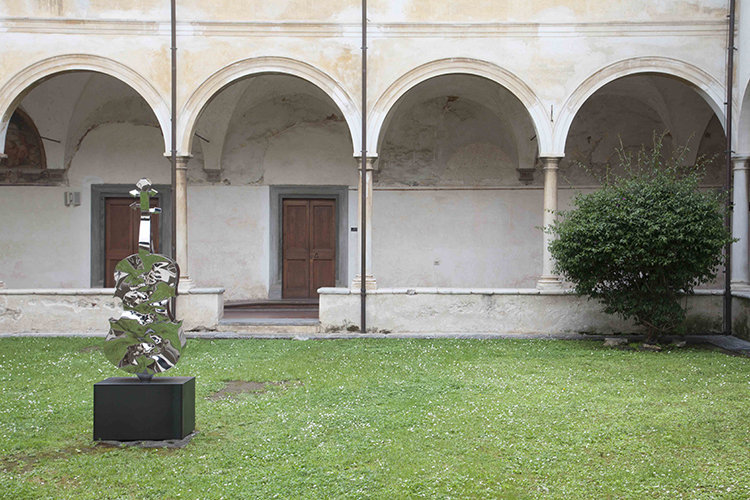
Helidon Xhixha, “Shining Rock” in Pietrasanta. Courtesy of Contini Art UK.
I think you must do the exact same thing in your daily life; you must take care of things from beginning to end. You can have the best collaborators in the world, but you have to be responsible for supervising all activities, otherwise things won’t work, they won’t get accomplished.
This is a very challenging exhibition. It is one thing is placing artworks inside exhibition rooms, but another decorating a 15th-century piazza with sculptures. You want to make it look like they’ve always been there, without adding or taking away anything, as the piazza itself is already a monument.
Now you’re talking like a curator, rather than a politician! As an Italian, I’ve always complained that our cultural institutions are managed by politicians who know nothing about art. Why are you the first one I’ve met who knows what he’s talking about?
Right after I was elected mayor of Pietrasanta, I basically cornered the old manager of an art gallery—a great art dealer, unfortunately now deceased—and said, “Could you tell me something, please? In art, how do I distinguish something beautiful from something ugly? This is a city of the arts and my task is to raise its standing, so I need to ban cars from the city center and place works of art in the streets.”
He replied, “You’ll never find that out. But you will find out what you like and what you don’t. You’ll know when you like something, not only because you’ll feel it, but also because there will be a vibration inside you. If you can feel a message coming to you from a work of art, then that work of art is beautiful for you, which doesn’t necessarily mean that it’s objectively beautiful.”
Imagine that you had just been elected as Prime Minister. What would you change in Italy as far as the art world is concerned?
There are two tracks, history and contemporary art.
Italy is home to three-quarters of the world’s cultural treasures, many of which are in the basements of museums and other state-owned facilities. Given the constant lack of financial resources, there’s only one thing to do.
We need to make sure that the Italian government, rather than the current 65 percent art bonus, provides for a 100 percent art bonus with an additional 10 percent incentive and encourages leading international investors to come to Italy and invest in Italy’s artistic and cultural heritage.
Why am I talking about foreign companies coming to Italy? If I can attract 10, 100, 10,000, a million foreign companies that wish to come to invest on my national territory, if I can convince them that coming to Italy is convenient not only because of the good food, nice life, beautiful weather, and excellent workers, but also because the state grants you a tax bonus and, through that bonus, finances artistic, and cultural activities and the preservation of its cultural heritage, well, I think that’s a very important achievement.
As for the promotion of contemporary art, the marriage between history and contemporary art is of fundamental importance. I like to imagine a Pop art exhibition at the Uffizi, for instance. If I could organize a show, let’s say on Giuseppe Veneziano or Robert Indiana, in the Vasari Corridor, I would. It would be beautiful.

Helidon Xhixha, “Shining Rock” in Pietrasanta. Courtesy of Contini Art UK.
I know you’re also looking to establish partnerships with leading international universities to bring young people to Pietrasanta. There are so many available spaces here, and not just for activities, directly connected with the artistic tradition of the city. What would it mean to help foster new generations of artists and art experts by making study abroad experiences available to those students who could not otherwise afford them?
Leaving aside the question of formal borders, it is my opinion that today there should be no boundaries. We constantly see highly qualified or talented Italians move abroad. I wish that highly qualified or talented foreigners came to Italy, too.
The problem is that here we have to put in place the necessary facilities to ensure that these qualified and talented foreigners progress and succeed. We must learn from those who know how to do this.
We must welcome these foreign universities and their culture of internationalization on our territory, we must make sure that they are given the necessary venues and facilities. We’ll provide “the hardware,” they’ll provide “the software,” and the two of us together will try to create a joint venture between our worlds, combining the experience of foreign countries and the Italian school and university system in order to promote education and research, including the study of craftsmanship.
For example, we restored Pietrasanta’s Franciscan settlement, a 14th-century monastery (now managed by the municipal authority) with guest rooms that accommodate a total of 25 people and classrooms that can be used for educational activities. It could be the right place for postgraduate courses, maybe with a focus on a topic related to art since it is also a visual arts center.
So, why don’t we contact the president of Boston’s Harvard University, the president of the Rhode Island School of Design and the dean of Goldsmiths University of London and make them a nice offer?
Sounds great.

Helidon Xhixha, “Shining Rock” in Pietrasanta. Courtesy of Contini Art UK.
You seem to be very proactive with regard to contemporary art. Given the importance of architecture to your city, would you be interested in inviting an architect to create a temporary summer pavilion in Pietrasanta?
It has been both a long-term ambition and a great dream of mine to achieve something similar to London’s Summer Pavilion at the Serpentine Gallery here in Pietrasanta. Our region has played a vital role in architecture globally through our exportation of the world’s finest marble; it seems fitting now to offer the opportunity for contemporary architecture to find a home in Pietrasanta.
The idea of such a pavilion in our town would help to raise the profile, status, and importance of architecture in this region, highlighting its status and contemporary significance.
Given the amenities that we have in our area, our marble quarries and metal foundries, Pietrasanta can become a leading stage for architecture, in the same way that we have for contemporary art. To bring together new generations of architects, and to have our own thriving architectural community, would be a huge honor.